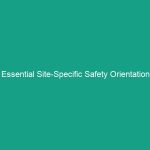Introduction
Good morning team,
Today, we are diving into an important topic: Essential Guidelines: When Safety Can Be Redundant in HSE Practices. It’s crucial to understand that while Safety practices are designed to protect us, there are situations where they may become redundant or counterproductive. This discussion is vital as it can help us streamline our processes, reduce unnecessary risks, and enhance our overall safety culture.
Understanding when Safety Measures can become redundant not only helps us maintain efficiency but also ensures we focus on what truly matters in our daily operations. So, let’s explore this topic together!
Understanding Essential Guidelines: When Safety Can Be Redundant in HSE Practices
The term **safety redundancy** refers to practices or protocols that, while well-intentioned, may no longer provide value in certain contexts. It’s important to recognize that safety is not a one-size-fits-all approach. Each workplace is unique, and the application of Safety Measures should be tailored accordingly.
In our workplace, safety redundancies can occur when employees follow outdated protocols, or when excessive measures hinder productivity without significantly increasing safety. The key is to regularly evaluate our practices to ensure they align with our current Environment and risk levels.
Common misconceptions include the belief that more safety measures always equal better safety. In reality, an overload of safety practices can lead to confusion, complacency, and even increased risk of accidents.
Key Hazards, Risks, and Safety Considerations
Identifying specific Hazards associated with redundant safety practices is crucial. Here are some potential risks:
- Complacency: When employees become too accustomed to excessive safety measures, they may overlook critical warnings and protocols.
- Increased Stress: Overly complex safety Procedures can cause stress and frustration, leading to decreased job satisfaction and productivity.
- Resource Wastage: Implementing unnecessary safety measures can waste time, materials, and financial resources that could be better utilized elsewhere.
Ignoring these aspects can lead to severe consequences, such as workplace injuries, reduced morale, and even increased turnover rates as employees seek environments with better-balanced safety practices.
Best Practices, Procedures, & Actionable Advice
Now that we’ve identified the potential hazards, let’s focus on some Best Practices to ensure our safety protocols are effective and relevant:
1. Regular Safety Audits
Conduct regular audits of safety practices to assess their effectiveness. Involve employees in the process to gain insights from their experiences.
2. Employee Training
Provide ongoing training to ensure that employees understand the reasoning behind safety measures. This helps them recognize when certain practices may be redundant or ineffective.
3. Engage in Open Communication
Encourage employees to voice their concerns and suggest improvements. Create an open dialogue about safety practices and involve everyone in the decision-making process.
4. Focus on Risk Assessment
Regularly assess risks in the workplace. Use a risk matrix to identify which hazards require stringent safety measures and which can be relaxed.
5. Case Study: Streamlining Safety Protocols
Let’s look at a real-world example. At XYZ Corp, employees found that a mandatory two-person rule for certain tasks was slowing down productivity without significantly increasing safety. After reviewing incident reports and risk assessments, management allowed for single-person operations in low-risk situations. This change led to a 20% increase in productivity without compromising safety.
Regulations, Standards, and Compliance
Staying compliant with safety Regulations is essential. Here are some relevant Standards:
- OSHA Standards: The Occupational Safety and Health Administration provides guidelines that can help determine which safety measures are necessary and which may be redundant.
- ISO 45001: This global standard for Occupational Health and safety management systems encourages organizations to continually improve safety practices, ensuring redundancy is minimized.
- Company-Specific Regulations: Always refer to our internal Safety Guidelines. They are tailored to our unique work environment and can help identify redundant practices.
Compliance is not just about following the rules; it’s about protecting our workforce and promoting a culture of safety. Understanding when to adapt these regulations can lead to a more efficient and safer workplace.
Employee Engagement & Discussion
Now that we’ve covered the essentials, let’s open the floor for discussion. Here are some questions to consider:
- What safety challenges have you encountered related to redundant practices?
- Can you think of any safety measures that seem unnecessary in your daily tasks?
- How can we improve our safety protocols to better reflect our actual working conditions?
Please take a moment to share your thoughts. Your feedback is invaluable in creating a safer and more efficient workplace.
Conclusion & Key Takeaways
In conclusion, understanding when safety can be redundant in HSE practices is essential for maintaining a balanced and effective safety culture. Here are the key takeaways:
- Evaluate safety practices regularly to determine their relevance.
- Engage employees in discussions about safety protocols to gather insights.
- Focus on risk assessment to streamline safety measures without compromising security.
Let’s prioritize safety by staying adaptive and open to change. Thank you for your attention today and for your commitment to creating a safer workplace for everyone. Together, we can improve our safety practices and ensure a productive environment!


